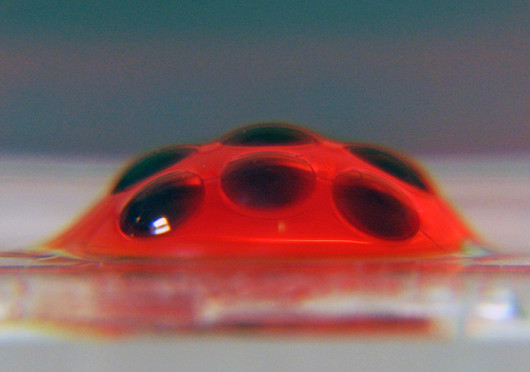
The Insect-Human Hybrid Eye lens has a dome-like surface with human-like lenses on top.
Credit: Courtesy of Kang Wei
A new lens developed by Ohio State biomedical engineers combines the traits of human vision with that of an insect. Called the Insect-Human Hybrid Eye, the lens is able to capture a wide field of view and adjust focal points to perceive depth and adapt its focus.
Insects have compound eyes, which are an arrangement of many lenses on a spherical surface, said Kang Wei, a Ph.D. candidate in biomedical engineering. Because of this construction, insects have a 180-degree view but no ability to focus on an object, which severely limits their range of sight. Human eyes have a small field of view but can change focus by contracting the ciliary muscle, he said.
“We put human-like liquid lenses on top of a spherical dome so we can make sure the lens has an adjustable focus, but we can also increase the viewing angle by borrowing the insect’s eye structure,” Wei said.
The IHHE lens has potential for clinical applications. Wei is currently working to implement its use in laparoscopic surgery. These minimally invasive operations require the use of tiny single-lens cameras to function as the surgeon’s eyes inside of the patient.
“In minimal invasive surgeries, it could give you a wider view inside the human body,” said Hansong Zeng, who graduated with a Ph.D. in biomedical engineering in 2012, in an email. Zeng was the first to design the device and prove its functionality. After he graduated, Wei took over with experimenting and validating the lens’ uses.
“Right now, laparoscopy is only a solid lens. When a surgeon places a laparoscope through the abdomen, they cannot know how far the instrument is to the surgical target because they cannot change focus,” Wei said.
During these procedures, the surgeon must constantly rotate the laparoscope to get an entire view, Wei said, but with the newly designed lens, that wouldn’t be necessary.
“It becomes easier to understand the topography of the inner organs and surgical environment,” said Yi Zhao, associate professor of biomedical engineering and ophthalmology who also worked on the lens. By replacing the traditional solid lens with the IHHE lens, a surgeon has not only a more advantageous view, but can change focus and perceive depth. This can help make these surgeries safer and quicker, Zhao said.
The lens can also be applied to photography to help create a pseudo-three-dimensional image, Zhao said. The human eye can perceive depth in pictures even though cameras do not truly capture the spatial differences. This lens could offer depth information and change the cameras in smartphones or even robotic spy technology for the military, he said. Several universities have been working on developing robotic insects to function as miniature spies.
“These spies can just fly in your window and take a look around and send information back to base,” Zhao said. This information becomes even more invaluable if the cameras can provide a sense of depth to the layout of whatever they are surveying.
Zhao predicts several more years and millions of dollars before the device can be put to use in the medical field or photographic technology, but said he hopes the government will provide financial support for additional research and development.


